Disclaimer: Please keep in mind these are just my personal opinions from watching the match engine. I do not claim that I'm 100% right on anything. Also, I know that statistics are much valued on these forums, but this is more of a visual analysis, so I can't really provide any.
I've spent the last few days watching match engine a lot (whole games). I mainly wanted to understand how the whole thing works, in particular player movements and attacking patterns. These are some of my observations.
Additional focus in this post will be on the currently top rated tactic (https://fm-arena.com/thread/4727-major-4-1-2-3-delicious/) and why I think it works so well compare to all others - at least from eye test. I will also not focus on Team Instructions, since I haven't seen that much impact, other than some things like: Roll it out vs Take long kicks, Distribute to..., Defensive line height, Line of engagement height, width, etc. Most of them affect default formation depth or how the ball is handled once the goalkeeper has it.
The position you see on the tactic screen is the position the team will be in once they get the ball.
Things I've noticed:
Formation is fluid The whole formation moves as ball moves around (logical). So the whole formation moves around the field as the attack progresses. Also on things like throw-ins or goal kicks, the whole formation moves towards the side of the ball.
Players generally stick to the formation Players will generally stick to the original formation. There are cases when they would deviate from it: - They see open space AND have the ball - they will rarely run into an open space without the ball unless the formation moved up - they will respect the formation. But if they have the ball and instruction to run with the ball - if there's space, they will do it and formation will follow them. - They have the ball and someone is pressuring them - they will try to keep it and deviate from formation - If they start marking a player, they can get dragged. Even strikers can get dragged all the way back to the box.
Player movement instructions - When players have instructions like Get further forward or Hold Position, that means that they will apply those instructions within the formation, not the whole pitch. E.g. If you have a Winger, set to Attack and Get further forward when team has the ball, it doesn't mean that he will run in line with strikers, he will just go further forward from his expected position within the formation. More on that below.
Player mentality and movement What I've noticed regarding mentality:
- Defend - Players with Defend mentality (Hold position) will only move with the formation as the formation moves. They will never go before it moved. - Support - Players with Support mentality will start fulfilling their movement directions once it's time to move the line. - Attack - Players with Attack mentality start fulfilling their movement directions slightly before the formation needs to move up - they're anticipating the move and leading the formation.
E.g. LWB is still not fulfilling his movement directions yet, since he's pressured. RWB (support) starts to fulfil his duties (cut inside) since he's set to support and it's time to move the formation up (ball moved up the field and we have possession). The formation has basically move up already here, since you can how high are defenders (that are set to hold position and they mark the beginning of the formation).
Once the ball is moved further down, LWB also starts cutting in as his instructions say.
Notice that DWs (Support) are still not moved up as you would expect with get further forward. Now when the ball gets to the next player, they will start moving up as the formation needs to be moved up - remember they're on support duty. Meanwhile, the strikers are moving up all the time (not up the pitch all the way, but within the formation - see how further up they got from DWs from the first picture).
Another example
Right winger got a sudden pass into space and he starts deviating from the formation by running with the ball (as mentioned before as one possible reason for deviation). Strikers will now run in since they're anticipating further formation movement forward. While the ball was in midfield a moment earlier, you can see IWBs on Support moved up from the designated position in the formation.
The interesting thing here is the left winger. He has Get further forward set in the instructions, but he only moves a little bit from where he should be. The reason again is that the formation is still positioned lower down the pitch, and he only moves forward within the formation, not the pitch. He will only get to the box once the formation goes forward even more.
DM on the other hand, also moved up a bit even though he has Hold Position, but also has Support - meaning he's moving the formation up, and is moving to his spot-to-be in the moved up formation. If he was set to hold position and defend, he would be in his circle, or much closer to it. So still going forward but following the formation.
Finally, when the formation goes all the way forward, you can think of it as being moved all the way, and players stay in the box - since obviously they can't move outside of the pitch.
More on player mentality:
Aside from dictating when the players move within the formation, mentality + role also moves the player slightly in the formation editor. That will also be reflected on the field when starting an attack. And then the mentality will determine when does the movement happen (as described before). E.g.
Gameplay
- Plays run most fluidly when each player has space. I've noticed that if two players are too close to each other, they won't really make any breakthrough often. There's no such thing as short one-two or something, also they'll try to avoid each other it feels like. The most opportunities come from a player sending a ball towards player which doesn't have much defenders around him and can go for a run (I guess same as in the real football). That makes running plays through wings much more effective then through the middle when there' usually a lot of opponent players. - Another reason why running plays through wings is superior, is because even if the opponent team has two DMs, and you have no midfielders, they will stay within the formation and not chase your wingers unless they are somewhat close to the winger by chance - for example: winger holds the ball for too long -> opposition formation moves towards that player slowly -> by moving the formation DM moved within the range where he's close enough to your winger -> starts moving to your winger -> starts tackling him if he didn't get rid of the ball. I assume that's why higher tempo works better, it moves the ball faster so there's less defenders sticking - When setting up a tactic, the positions that are horizontal to each other, have enough space in the game. For example, two AFs will always have enough space between them (by the nature of the formation movement, since the formation moves up/down mostly and is less constricted vertically). Meanwhile, positions that are vertical to each other tend to clash and leave less space between players, making their connection less effective. E.g. SS and AF, especially if they're in the same line (even though when setting up tactic it seems they're equally spaced)
It's because AF(Attack) defines the top of the formation, and SS has an attacking mentality, and anticipates formation moving forward by going into the AFs position pretty much.
Other random observations
- Players will rarely understand that if they pass the ball back, their teammate will have space to open up the side for example. They will usually always pass forward unless they're pressured or literally have no option. - I noticed that MCs and AMCs are mostly good for defense, unless they're amazing players and have some crazy solo moves. They move around the middle of the field and stick to a lot of players in the process. Almost all defending in the game is just the player sticking to an opponent nearby. Offensively, they mostly contribute if the ball bounces back to them as the striker misses, or they get into the box if the formation is completely moved up. In terms of creation they are usually covered by a lot of players and don't create much direct threats. - When you talk about finding the strikers with a long pass so they can run towards the goal, I've seen it a lot more coming from DMs then AMCs for example. Because when you get the possession, it's usually DM that gets the ball first and there's space in the back since opponent formation is still moved further up. And as they're going back if you have AMC someone will immediately stick to it, which makes AMC not so effective for giving these balls into space for strikers. - Players on the wing need support: A lot of chances come from the player having the ball on the sidelines, another player coming towards him since he's pressured, and then once he gives him the ball, he plays it back for him into the space. This is so effective in these top tactics with DWs, IWBs and AFs on the sides. Both wingers and those side strikers have support player just by formation design. In standard 4-1-2-2-1 with IFs and WBs, both wingbacks and MCs are formation-wise too far away from the IF, especially if he just received the ball. Plus AF is sitting narrower so he's also farther then striker in 3-man setup.
Good support:
- I've always had a misconception that If I make a tactic for example with WingBacks set to attack, that once we have possession, they go all the way up as if they were IFs, but you can see that that's not the case, they also go up the formation (get further forward) and a bit earlier (Attacking), but they're not actually gonna go join the attack before the formation has moved all the way up.
Why is this formation effective?
As already stated, this is the formation I've been studying and comparing to other ones:
IMO, if you look at all the things I've mentioned, this checks all the boxes.
- Basically three players involved into attack on both flanks IWBs, DWs, AFs with two vertical spaces between them - no one close to each other. - IWBs are using the flank less, since they start cutting in, but they have DWs to continue. With WBs and IFs, they are usually far away from each other and WBs have no pass when they get pressured. - Enough space between every player (no one on the same line vertically, unless at least two spaces apart, like IWBs and DWs) - No midfield - DM and BPDs join in later for support if ball bounces back - DMs look more for AFs with through balls, since there's no one in between to target with the pass - 3 guys on each flank instead of 2 also means more defense on the flanks, which is also what AI uses the most for attacking. - Even when AI has two MCs, that one DM and IWBs that are closer are enough to discourage them from being offensive and they look for open spaces on the wings - 2-3 guys can pressure every wing (IWB, DW, and DM if he holds the ball for too long) - Three AFs instead of 2 make the ones on the side closer to the flank meaning much more prone to interact with the wingers. Two are often too passive since they're far away. - AFs being already in the position allows for faster counters and more space, compared to IFs that usually join when the formation has moved up significantly
This is all I can think of right now. Some things might be obvious or known to you from before. But I hope you can find at least a single useful information
Also, this is not a definitive explanation of how things look on the pitch - yes, players sometimes have crazy mistakes or insane plays, but it seems a lot more often when you watch key/extended highlights compared to watching the whole game. Have fun
Something I want to point out here is that in the testing league this tactic comes up against with only three tactics and with relatively defined team instructions for AI Teams/Managers.
I agree with everything you have written. Well done!
Disclaimer: Please keep in mind these are just my personal opinions from watching the match engine. I do not claim that I'm 100% right on anything. Also, I know that statistics are much valued on these forums, but this is more of a visual analysis, so I can't really provide any.

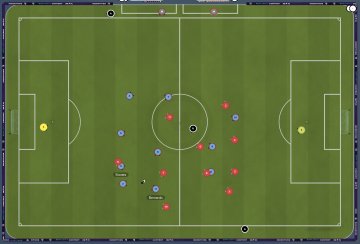
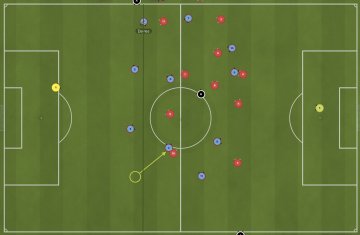
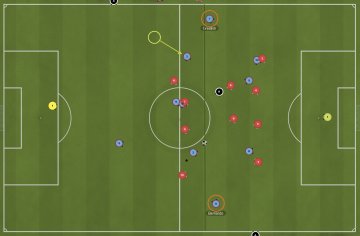




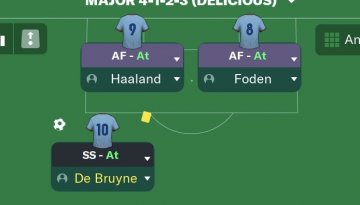
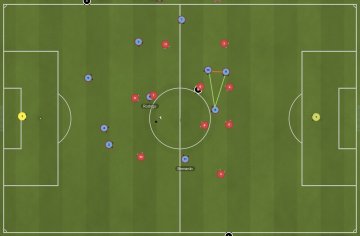
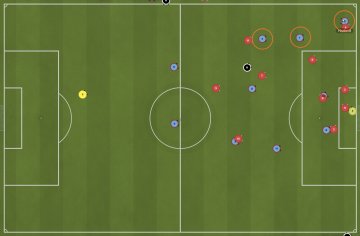

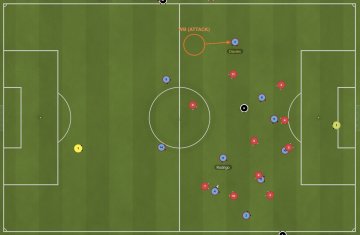


I've spent the last few days watching match engine a lot (whole games). I mainly wanted to understand how the whole thing works, in particular player movements and attacking patterns. These are some of my observations.
Additional focus in this post will be on the currently top rated tactic (https://fm-arena.com/thread/4727-major-4-1-2-3-delicious/) and why I think it works so well compare to all others - at least from eye test. I will also not focus on Team Instructions, since I haven't seen that much impact, other than some things like: Roll it out vs Take long kicks, Distribute to..., Defensive line height, Line of engagement height, width, etc. Most of them affect default formation depth or how the ball is handled once the goalkeeper has it.
Note: in all screenshots I'm using the aforementioned top rated tactic(https://fm-arena.com/thread/4727-major-4-1-2-3-delicious/), unless specified otherwise.
Default Player Position
The position you see on the tactic screen is the position the team will be in once they get the ball.
Things I've noticed:
Formation is fluid
The whole formation moves as ball moves around (logical). So the whole formation moves around the field as the attack progresses. Also on things like throw-ins or goal kicks, the whole formation moves towards the side of the ball.
Players generally stick to the formation
Players will generally stick to the original formation. There are cases when they would deviate from it:
- They see open space AND have the ball - they will rarely run into an open space without the ball unless the formation moved up - they will respect the formation. But if they have the ball and instruction to run with the ball - if there's space, they will do it and formation will follow them.
- They have the ball and someone is pressuring them - they will try to keep it and deviate from formation
- If they start marking a player, they can get dragged. Even strikers can get dragged all the way back to the box.
Player movement instructions
- When players have instructions like Get further forward or Hold Position, that means that they will apply those instructions within the formation, not the whole pitch. E.g. If you have a Winger, set to Attack and Get further forward when team has the ball, it doesn't mean that he will run in line with strikers, he will just go further forward from his expected position within the formation. More on that below.
Player mentality and movement
What I've noticed regarding mentality:
- Defend - Players with Defend mentality (Hold position) will only move with the formation as the formation moves. They will never go before it moved.
- Support - Players with Support mentality will start fulfilling their movement directions once it's time to move the line.
- Attack - Players with Attack mentality start fulfilling their movement directions slightly before the formation needs to move up - they're anticipating the move and leading the formation.
E.g. LWB is still not fulfilling his movement directions yet, since he's pressured. RWB (support) starts to fulfil his duties (cut inside) since he's set to support and it's time to move the formation up (ball moved up the field and we have possession). The formation has basically move up already here, since you can how high are defenders (that are set to hold position and they mark the beginning of the formation).
Once the ball is moved further down, LWB also starts cutting in as his instructions say.
Notice that DWs (Support) are still not moved up as you would expect with get further forward. Now when the ball gets to the next player, they will start moving up as the formation needs to be moved up - remember they're on support duty. Meanwhile, the strikers are moving up all the time (not up the pitch all the way, but within the formation - see how further up they got from DWs from the first picture).
Another example
Right winger got a sudden pass into space and he starts deviating from the formation by running with the ball (as mentioned before as one possible reason for deviation). Strikers will now run in since they're anticipating further formation movement forward. While the ball was in midfield a moment earlier, you can see IWBs on Support moved up from the designated position in the formation.
The interesting thing here is the left winger. He has Get further forward set in the instructions, but he only moves a little bit from where he should be. The reason again is that the formation is still positioned lower down the pitch, and he only moves forward within the formation, not the pitch. He will only get to the box once the formation goes forward even more.
DM on the other hand, also moved up a bit even though he has Hold Position, but also has Support - meaning he's moving the formation up, and is moving to his spot-to-be in the moved up formation. If he was set to hold position and defend, he would be in his circle, or much closer to it. So still going forward but following the formation.
Finally, when the formation goes all the way forward, you can think of it as being moved all the way, and players stay in the box - since obviously they can't move outside of the pitch.
More on player mentality:
Aside from dictating when the players move within the formation, mentality + role also moves the player slightly in the formation editor. That will also be reflected on the field when starting an attack. And then the mentality will determine when does the movement happen (as described before). E.g.
Gameplay
- Plays run most fluidly when each player has space. I've noticed that if two players are too close to each other, they won't really make any breakthrough often. There's no such thing as short one-two or something, also they'll try to avoid each other it feels like. The most opportunities come from a player sending a ball towards player which doesn't have much defenders around him and can go for a run (I guess same as in the real football). That makes running plays through wings much more effective then through the middle when there' usually a lot of opponent players.
- Another reason why running plays through wings is superior, is because even if the opponent team has two DMs, and you have no midfielders, they will stay within the formation and not chase your wingers unless they are somewhat close to the winger by chance - for example: winger holds the ball for too long -> opposition formation moves towards that player slowly -> by moving the formation DM moved within the range where he's close enough to your winger -> starts moving to your winger -> starts tackling him if he didn't get rid of the ball. I assume that's why higher tempo works better, it moves the ball faster so there's less defenders sticking
- When setting up a tactic, the positions that are horizontal to each other, have enough space in the game. For example, two AFs will always have enough space between them (by the nature of the formation movement, since the formation moves up/down mostly and is less constricted vertically). Meanwhile, positions that are vertical to each other tend to clash and leave less space between players, making their connection less effective. E.g. SS and AF, especially if they're in the same line (even though when setting up tactic it seems they're equally spaced)
It's because AF(Attack) defines the top of the formation, and SS has an attacking mentality, and anticipates formation moving forward by going into the AFs position pretty much.
Other random observations
- Players will rarely understand that if they pass the ball back, their teammate will have space to open up the side for example. They will usually always pass forward unless they're pressured or literally have no option.
- I noticed that MCs and AMCs are mostly good for defense, unless they're amazing players and have some crazy solo moves. They move around the middle of the field and stick to a lot of players in the process. Almost all defending in the game is just the player sticking to an opponent nearby. Offensively, they mostly contribute if the ball bounces back to them as the striker misses, or they get into the box if the formation is completely moved up. In terms of creation they are usually covered by a lot of players and don't create much direct threats.
- When you talk about finding the strikers with a long pass so they can run towards the goal, I've seen it a lot more coming from DMs then AMCs for example. Because when you get the possession, it's usually DM that gets the ball first and there's space in the back since opponent formation is still moved further up. And as they're going back if you have AMC someone will immediately stick to it, which makes AMC not so effective for giving these balls into space for strikers.
- Players on the wing need support: A lot of chances come from the player having the ball on the sidelines, another player coming towards him since he's pressured, and then once he gives him the ball, he plays it back for him into the space. This is so effective in these top tactics with DWs, IWBs and AFs on the sides. Both wingers and those side strikers have support player just by formation design. In standard 4-1-2-2-1 with IFs and WBs, both wingbacks and MCs are formation-wise too far away from the IF, especially if he just received the ball. Plus AF is sitting narrower so he's also farther then striker in 3-man setup.
Good support:
- I've always had a misconception that If I make a tactic for example with WingBacks set to attack, that once we have possession, they go all the way up as if they were IFs, but you can see that that's not the case, they also go up the formation (get further forward) and a bit earlier (Attacking), but they're not actually gonna go join the attack before the formation has moved all the way up.
Why is this formation effective?
As already stated, this is the formation I've been studying and comparing to other ones:
IMO, if you look at all the things I've mentioned, this checks all the boxes.
- Basically three players involved into attack on both flanks IWBs, DWs, AFs with two vertical spaces between them - no one close to each other.
- IWBs are using the flank less, since they start cutting in, but they have DWs to continue. With WBs and IFs, they are usually far away from each other and WBs have no pass when they get pressured.
- Enough space between every player (no one on the same line vertically, unless at least two spaces apart, like IWBs and DWs)
- No midfield - DM and BPDs join in later for support if ball bounces back
- DMs look more for AFs with through balls, since there's no one in between to target with the pass
- 3 guys on each flank instead of 2 also means more defense on the flanks, which is also what AI uses the most for attacking.
- Even when AI has two MCs, that one DM and IWBs that are closer are enough to discourage them from being offensive and they look for open spaces on the wings
- 2-3 guys can pressure every wing (IWB, DW, and DM if he holds the ball for too long)
- Three AFs instead of 2 make the ones on the side closer to the flank meaning much more prone to interact with the wingers. Two are often too passive since they're far away.
- AFs being already in the position allows for faster counters and more space, compared to IFs that usually join when the formation has moved up significantly
This is all I can think of right now. Some things might be obvious or known to you from before. But I hope you can find at least a single useful information
Also, this is not a definitive explanation of how things look on the pitch - yes, players sometimes have crazy mistakes or insane plays, but it seems a lot more often when you watch key/extended highlights compared to watching the whole game. Have fun
Good explanation, and your observations while watching the game were also insightful.
Something I want to point out here is that in the testing league this tactic comes up against with only three tactics and with relatively defined team instructions for AI Teams/Managers.

I agree with everything you have written. Well done!